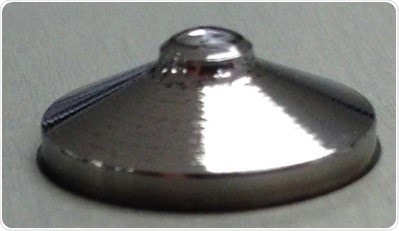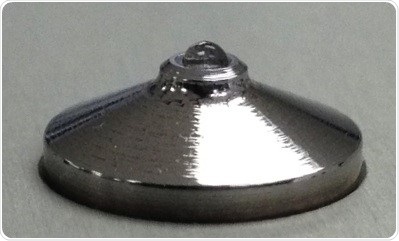During microvolume measurements, incorrect measurements can result if the liquid sample is not bridged throughout the entire measurement cycle. Microvolume spectrophotometers are unique instruments that largely depend on the liquid’s surface tension to close the air gap between the lower and upper sampling surfaces.
The following sections discuss the typical causes that contribute to the unbridged measurements, and how these issues are eliminated with the DeNovix DS-11 Spectrophotometer using SmartPath® Technology with BridgeTesting®.
DS 11 Series | Spectrophotometer | Fluorometer
Causes of Unbridged Measurements
Improper Sample Size
Care must be taken to ensure that errors do not occur during pipetting of samples, because most often users fail to detect such errors. Dispensing less than the preferred sample size is also a common practice.
These issues can be attributed to two factors: pipette tips that do not fit adequately tend to affect the pipettor’s plunger action and as a result, the fluid is not allowed to dispense fully, alternatively samples tend to stick to the tip of the pipette rather than fully dispensing onto the surface of the sample (Figure 1).

Figure 1. Example of liquid sample adhering to the side of a pipette tip resulting in a mis-loaded aliquot. Green coloring was added to the sample to enhance visibility for demonstration purposes. Image credit: DeNovix
Some samples, such as purified proteins, tend to cling to the tip of the pipette instead of loading onto the surface of the measurement. Regardless of the initial reason, sample pipetting error can result in less than the preferred sample volume being delivered to the measurement surface of the sample.
Inadequate volumes of samples can also lead to an unbridged condition on certain spectrophotometers and as a result, inaccurate measurement data would be obtained. In most situations, users tend to believe that these instruments provide accurate sample concentration data, because they are unaware of the fact that an unbridged measurement has occurred.
Surface Unconditioning
A phenomenon called unconditioning is seen in a large number of microvolume spectrophotometers where the surface of the sample tends to lose its hydrophobic characteristic. When this occurs, the sample will disperse (Figure 2a) on the surface of the sample rather than beading up on its surface (Figure 2b).

Figure 2a. Unconditioned surface. Image credit: DeNovix

Figure 2b. Conditioned surface. Image credit: DeNovix
This phenomenon prevents the formation of a liquid bridge. Regular use of solvent- or detergent-based buffer causes this issue. This problem is difficult to detect for end users. Researchers should ensure samples are not lying flat on the sample surface and should take steps to thoroughly clean the sample surfaces to restore their hydrophobic nature.
Advantages of DS-11 Spectrophotometer
0.5mm Pathlength
The sample is compressed during measurements because the pathlength of the DS-11 microvolume spectrophotometer starts at 0.5mm and is only reduced from that point. This provides a significant benefit when compared to other commercially available microvolume spectrophotometers for which the pathlength is 1.0mm. In order to bridge the 1.0mm gap, standard spectrophotometers must extend the sample. When instruments relying on sample stretching are used to make measurements on unbridged samples, inaccurate results will be obtained owing to unconditioned surfaces or following a pipetting mis-load (Figure 3).

Figure 3. The DS-11(top row) contacts and maintains the liquid bridge between measurement surfaces throughout the entire measurement cycle. The initial liquid bridge may break under the same measurement conditions on a competitor's instrument (bottom row). Image credit: DeNovix
SmartPath® Technology with BridgeTesting®
A proprietary algorithm is integrated with the DS-11 microvolume spectrophotometer software to analyze an unbridged condition in the RNA, ssDNA, dsDNA and Protein A280 apps. With this component in the SmartPath® algorithm, the unbridged condition is easily detected and at the same time, accurate results are obtained without any user intervention. The results of 0.5μL dsDNA measurements performed on suitably conditioned surfaces are shown in Table 1.
Table 1. Ten replicates of 634ng/μL dsDNA (as measured on a reference Agilent 8453) were measured on a DS-11 and a competitor's instrument
|
Replicates
|
DS-11
|
Competitor
|
|
1
|
639.7
|
383.5
|
|
2
|
638.7
|
352.7
|
|
3
|
641.0
|
617.3
|
|
4
|
645.9
|
232.1
|
|
5
|
648.2
|
360.1
|
|
6
|
645.2
|
392.9
|
|
7
|
645.3
|
395.7
|
|
8
|
639.3
|
362.6
|
|
9
|
644.4
|
368.7
|
|
10
|
645.2
|
380.6
|
|
Average
|
643.3
|
384.6
|
|
%CV
|
0.51%
|
24.50%
|
|
% Error
|
1.42%
|
39.43%
|
A competitor product and the DS-11 were used to make these measurements with simulated mis-loaded samples of 1.0μL. The resultant data demonstrates that the DS-11 dsDNA app was able to determine all the samples accurately, while the competitor product provided inaccurate results in 9 out of 10 replicates within the same settings.
Accurate Microvolume Measurement Data
Unbridged sample measurements provide erroneous results, which often go unnoticed by end users of microvolume spectrophotometers. Featuring SmartPath® Technology with BridgeTesting®, the DeNovix DS-11 microvolume spectrophotometer prevents the common issues related to unbridged sample errors. This unique feature makes the DS-11 Spectrophotometer suitable for labs working with proteins and nucleic acids, and provides researchers with highly accurate microvolume measurement data.
About DeNovix, Inc.
WELCOME TO DENOVIX
Award-Winning products for Life Science
Our multi-award winning products include the Reviewers’ Choice Life Science Product of the Year and Platinum Seal awarded- DS-11 Series Spectrophotometer / Fluorometer and CellDrop™ Automated Cell Counter. CellDrop is the first instrument of its kind to Count Cells Without Slides. These powerful instruments integrate patented DeNovix technology with easy-to-use software designed by life scientists for life scientists.
Researchers tell us they love the industry leading performance, smart-phone-like operation, and the flexible connectivity of the instruments. When support is needed, the DeNovix team is here to help. DeNovix received the prestigious Life Sciences Customer Service of the Year based on independent reviews posted by scientists worldwide!
CellDrop: Sustainable laboratory product of the year
The CellDrop Automated Cell Counter has been awarded Sustainable Laboratory Product of the Year in the SelectScience® Scientists’ Choice Awards®!
CellDrop’s patented DirectPipette™ technology distinguishes it as the only cell counter to eliminate the need for cell counting slides. This innovation saves millions of single-use plastic slides from use and disposal each year.
Sponsored Content Policy: News-Medical.net publishes articles and related content that may be derived from sources where we have existing commercial relationships, provided such content adds value to the core editorial ethos of News-Medical.Net which is to educate and inform site visitors interested in medical research, science, medical devices and treatments.